|
BULB LOG 17 26th April 2006

Portable studio
I mentioned my temporary plastic house last week which I was using for extra protection and cover for flowering plants and here is a closer look at the other use I am putting it to. It is ideal as a photographic studio as it eliminates the problems of the flowers waving about in the wind which means that I can use slower shutter speeds, allowing me to use a very small aperture to maximise the depth of field in the pictures. I have a string going from side to side from which I hang my grey back- ground board held on with a couple of clothes pegs - this arrangement allows for very quick and easy height adjustment of the board. I can also hang white reflectors from the side rods to either shade the image from direct sunlight, which is never the best light to photograph flowers under, or to reduce the depth of shade on the side furthest from the light by reflecting some light back into the shadows. You can also see the distance away from the subject I can set my Fuji camera with its long focal lens and still get
a large image.
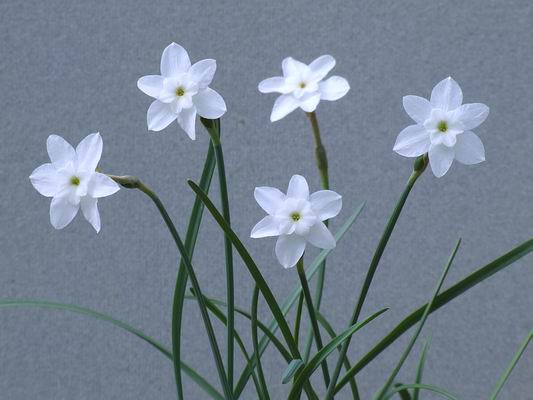
Narcissus watieri
This is the picture being taken above of a form of Narcissus watieri, raised from seed collected in the Atlas Mountains and distributed some years ago in the SRGC Seed Exchange.

Narcissus watieri and atlanticus
I thought it would be interesting to take a photograph that directly compares the flowers of Narcissus watieri and atlanticus. Narcissus watieri has a crystalline white flower while N. atlanticus has a creamy white flower with a deeper cup (corona).

Narcissus Craigton Coquette
Narcissus 'Craigton Coquette' is my own hybrid between Narcissus watieri and N. triandrus. I just love it as it captures the best qualities from both the parents and it is a steady if not rapid increaser. I know lots of people are after it and I am doing my best to distribute it but I can only have between 10 and 15 spare bulbs per year from the stock I keep, two pots full. It is one of those catch 22 situations because if I kept more to increase my stock which would then let me have a larger surplus in years to come I would not have distributed any at all. I also believe that it is best to spread plants around as quickly as I could have a bad season and lose it so it is a good insurance to have as many people growing it as possible.

Narcissus triandrus
This is Narcissus triandrus, the seed parent of 'Craigton Coquette'. I have never managed to keep Narcissus triandrus going for much more than three years if I am lucky, so it is vital that I get a good seed true set on to keep it in our collection. This is frustrating as it makes such a good parent and it hybridises so freely with many other Narcissus that the temptation to cross the few pots that I have is great.

Narcissus flowers
If you think I am showing a lot of Narcissus flowers this week you are correct and it is intentional. They never seem to feature so much on the log as some of the other bulbs like Fritillaria and Crocus yet we must grow as many if not more pots of Narcissus than the other main genera. This is just a small selection of the plants in flower just now and it should have included Narcissus cyclamineus but I managed to drop its flower and only discovered it lying on the ground after I had finished taking the pictures.
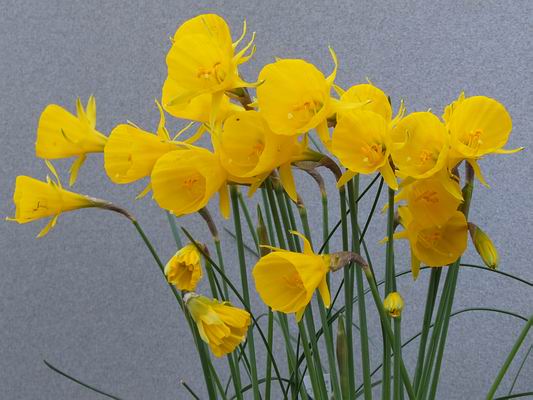
Narcissus bulbicodium obesus
Having been enjoying the winter-flowering members of the Narcissus bulbicodium group such as N. romieuxii and N. cantabricus since the first one flowered last October (or was it late September) we are now enjoying the Spring flowering forms such as Narcissus bulbicodium ssp obesus with its deep yellow blooms.
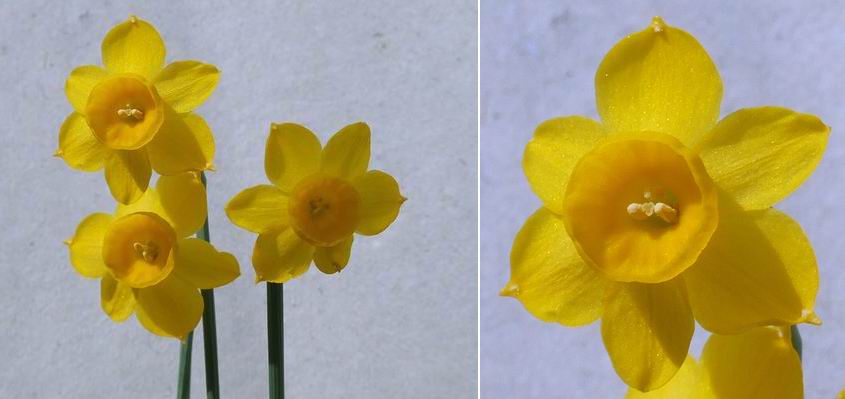
Narcissus cuatrecasasii
A tiny flower superficially similar to N. rupicola is Narcissus cuatrecasasii which can usually be distinguished by its small, deep evenly rounded cup shaped corona.

Narcissus Tenuior
Narcissus Tenuior has been in the records since being described in Curtis's Botanical Magazine in 1797 but no one is sure what it is or where it came from. It is thought to be a hybrid between a N. jonquilla and N. poeticus but it is not known if it is a wild hybrid or a cultivated one as there is no record of it being seen in the wild.
Harking back to a recent log, I showed a Narcissus which I called "Elit" ….. this was in fact, "Elite" a very old hybrid known from the late eighteenth century.

Narcissus Queen of Spain and Johnsonii
Narcissus 'Queen of Spain' on the left and N. 'Johnsonii' are two very similar plants with confused almost mythical histories in cultivation. If you enjoy detective stories then try unpicking the confusion and the number of plants that bear these names - I am as certain as I can be that I am showing you the correct two here.
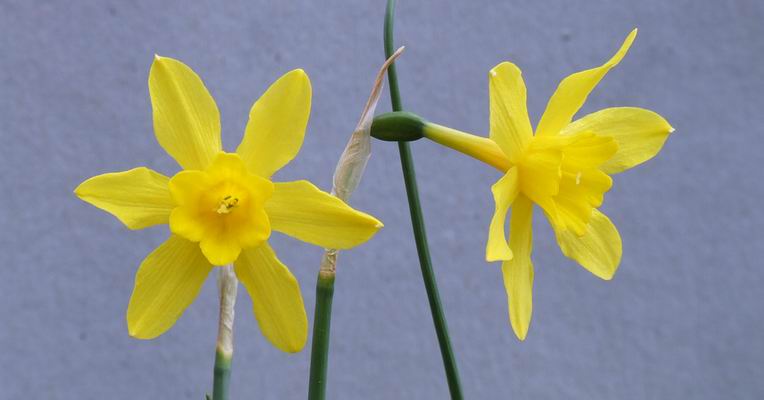
Narcissus unknown
How do plants get mixed up in cultivation you may ask - all too easily! Never mind the possibilities of seeds dropping from a plant into a neighbouring pot, when the most regular cause for confusion in our garden is labels going missing for whatever reason. This Narcissus has lost its label completely and I have no recollection of ever having seen it in flower before - I do not remember being given it recently so perhaps it is one of our seedlings: can any one help me out? Do you recognise this narcissus?

Scilla rosenii
Just so it is not all Narcissus, here is my favourite Scilla; S. rosenii with its fantastic blue flowers which when they are fully out and the petals recurve could almost be a blue erythronium.

Scilla rosenii closer
It likes the colder climate that we can offer it in the North as I have heard that it sometimes tries to open its flowers underground further south.

Corydalis seed
A few weeks back I showed you how to pollinate your Corydalis flowers to increase the chance of getting a good seed set. Now is the time to be watching carefully for the seed pods splitting. They do this amazing quickly and with out many obvious signs that they are ripe and about to split open - suddenly the two side plates are shed and the seed drops so have a pot ready to collect it. Corydalis seed is one of the few that I sow immediately it is shed.
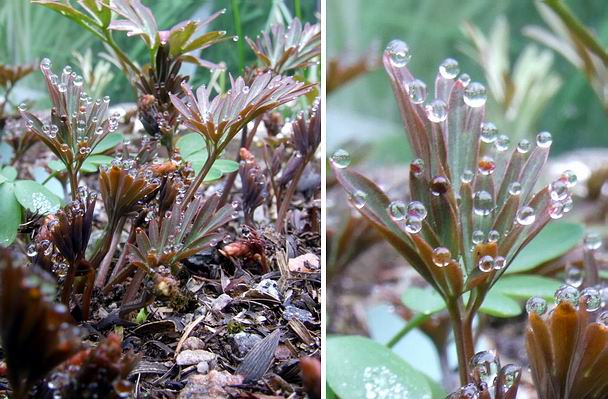
Diamonds on the ends of our leaves
If you know the well known Paul Simon song that has the line 'diamonds on the soles of her shoes' then sing along with us 'diamonds on the ends of our leaves'. It is beautiful the way the water droplets form on the ends of the emerging leaves of many species of Corydalis - this is C. turtschaninovii.
I am off to visit the wonderful Bulb Collection at Gothenburg Botanic Garden now, so next week's log may be a few days late!
^ back to the top ^
|

